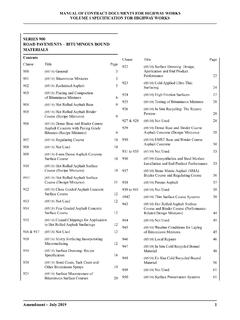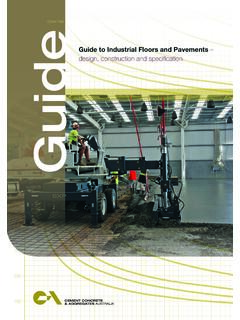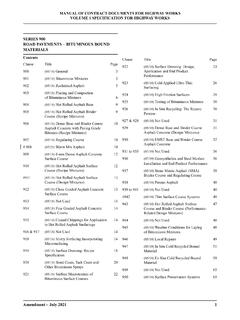Transcription of S.R. 21 - ANNEX E: 2016 - Roadstone
1 21 - ANNEX E: 2016. NOV 2017. Introduction In March of 2016 the NSAI published the updated version of Standard Recommendation 21 ( 21.). The Standard Recommendation's full title is, : Guidance on the use of EN 13242:2002 +A1 :2016 Aggregates for unbound and hydraulically bound materials for use in civil engineering work and road construction As you will be aware this includes, ANNEX E: Aggregates for use under (and adjacent to) concrete floors and footpaths. 21 also covers a wide range of products which are as follows, ANNEX A Aggregates for pipe bedding, haunching and surrounding material. ANNEX B Aggregates for backfilling of filter drains ANNEX C Aggregates for general fill material ANNEX D Aggregates for unbound sub-bases for road pavements ANNEX F Aggregates for cement bound materials With the exception of ANNEX E, each of these Annexes will refer you to the NRA Specification for Roadworks which will give more detailed information on the specified requirements for each material.
2 The NSAI have also published 888:2016:Code of Practice for the procurement and use of unbound granular fill hardcore material for use under concrete floors. It specifies requirements for post manufacturing operations of unbound granular fill (hardcore) for use under concrete floors and footpaths such as procurement, haulage, delivery and receipt, storage and handling, placing, traceability and record management, with an aim of improving the chain of custody within the supply chain and ensuring the complete traceability of hardcore suitable for this particular end-use, from the original manufacture and source of the location where it is incorporated into the works. 2. ANNEX E BACKGROUND TO CHANGES: In 2007, ANNEX E was added to SR21 in response to Further additions were made in 2016 to incorporate concerns about deleterious materials containing an optional structural unbound granular fill excessive pyrite having entered the supply chain from (hardcore) material, for use at depths greater than a small number of suppliers and resulting in structural 900mm depending on site conditions, settlement damage to a significant number of houses mainly in potential and other engineering factors and the new the Greater Dublin region.
3 Building Regulation requirements for a Radon Sump to be included in the sub-floor of all occupied new The 2014 revision is substantially on foot of the build projects, anywhere a person might be for Pyrite Panel Report 2012 issued by DECLG following work, leisure or residence. an enquiry into the matter. It had been revised by request of the Minister for the Environment to ensure granular fill used under concrete floors and footpaths will not cause an issue due to pyritic heave. The unbound Granular Fills now covered by SR 21. ANNEX E are described as follows, Structural Permeable Suitability graded structural unbound granular Suitably graded unbound granular fill material fill material (0/125mm), for use at depths greater (4/40mm) to facilitate the free movement of radon than 900mm below the radon barrier/damp proof gas within the hardcore area. membrane Blinding Structural Fine aggregate (0/4mm) GF 80, for blinding the top Structural unbound granular fill material is an all surface of the T2 Permeable material.
4 In graded aggregate (0-32mm) or gravel (0/40mm). to facilitate placing and compactability. (Current material). 3. GRANULAR FILL UNDER CONCRETE FLOOR: Blinding: 0/4mm blinding layer for - Max depth 50mm max Permeable: 4/40mm Gas Permeable layer (Radon) Min depth 200mm Structural: 0 crushed rock (0/40mm for crushed gravel). for use in depths of <900mm Structural: 0/125mm -for use in depths of > 900mm 4. 1. Application of Struc 0/125mm Struc unbound Granular Fill material is recommended for use where; a) the fill material will be subject to substantial loading and /or dynamic loading, or b) the depth of fill is greater than 900 mm to the top of the subsoil. 2. Application of Struc 0 unbound MATERIAL PROPERTIES. Granular Fill (Crushed Rock) or 0/40mm Grading Gravel STRUCTURAL LAYER (SR 21 Table ). Struc unbound Granular Fill material is recommended for use where; a) the overall depth of fill to subsoil is less than 900mm.
5 CRUSHED ROCK OR GRAVEL (0/125MM). (Most rising walls are 3 blocks high in the domestic/office scenario) and b) the loading would be normal domestic/office Overall Grading Range loading. ISO Sieve Size Percentage passing by mass Advantages of the use of Struc material exclusively include a) Most dwelling sites would only need one type of 200mm 100. material, b) Less confusion in ordering and placing of material, c) Current construction methods are maintained, d) Designer/ 125mm 98-100. assigned certifier makes the decision on the material to be specified based on the site/loading conditions. 100mm 75-99. 3. Application of Perm 4/40mm Gas Permeable Layer 40mm 55-85. Perm 4/40mm Gas Permeable Layer: Any building where a Radon Sump is to be operational in the sub-floor including all 10mm 15-45. occupied new build projects, anywhere a person might be for work, leisure or residence. 10-35. 4.
6 Application of Blind 0/4mm Blinding 1mm 5-20. Layer Blind 0/4mm Blinding Layer: For blinding the top surface .063mm f9. of the Permeable material to ensure the radon barrier is not punctured and there is a level surface upon which to place the insulation and pour the concrete. 5. Combination of T0/1 and T2&3 materials T 0/1 and T 2&3 materials where the site /loading conditions requires or Struc materials but also requires a gas permeable layer, (Type & material), the installation should incorporate a hybrid of the materials. This would involve the placing of a layer of the Perm material above the compacted or layer and below the blinding, where the radon extraction method can be placed. The layer should be in the order of 200mm depth. 5. STRUCTURAL LAYER (SR 21 TABLE ). Crushed Rock 0/31,5 Gravel 0/40. ISO Sieve Percentage passing by mass Percentage passing by mass Size mm Supplier Tolerance on Supplier Tolerance on Overall grading Declared Value the Supplier Overall grading Declared Value the Supplier range Grading Range Declared Value range Grading Range Declared (SDV) (SDV) (SDV) Value(SDV).
7 80 100. 63 100. 40 80-100. 80-100. 20 55-85 63-77 +8. 16 55-85 63-77 +8. 10 35-65 43-57 +8. 8 35-65 43-57 +8. 4 22-50 30-42 +8 22-50 30-42 +8. 2 15-40 22-33 +7 15-40 22-33 +7. 1 10-35 15-30 +5 10-35 15-30 +5. 0,5 0-20 5-15 +5 0-20 5-15 +5. 0,063(f ) 0-7(f7) 0-7(f7). NOTE 1 Test results should fall within the overall grading range. NOTE 2 The supplier should additionally declare the typical grading of the product - this supplier declared value (SDV). should lie within the SDV grading range. However, the SDV together with the relevant tolerances, is used solely for the purpose of the suppliers internal factory production control. 6. STRUCTURAL LAYER (SR 21 TABLE ). Sieve 80mm 63mm 40mm 8mm 4mm 2mm Size 4/40mm GTNR Gc80/2 100% 98-100% 80-99%* -NR -NR 0-20% 0-5%. Supplier Tolerance on Overall Declared the Supplier 100% 98-100% 80-99%* NR. grading range Value Grading Declared Range (SDV) Value (SDV).
8 * The inclusion of 99 % instead of 100 % is to ensure consistency and to prevent smaller size aggregates being classified as D size aggregate. However, EN 13242:2002+A1:2007, Table 2 , footnote d specifies that the percentage passing D may be greater than 99 % by mass but in such cases the producer is required to document and declare the typical grading including the sieves D, d, d/2. and sieves in the basic set plus set 2 intermediate between d and D. Durability Geological and Petrographic Assessment LA value now required to be a maximum of LA30 More explicit guidance is given on the geological and Sedimentary Mudrock content of the material shall not exceed petrographic assessment to limit the risk of swelling or sulfur 10% attack on concrete, due to the presence of a reactive form of Magnesium Sulphate Soundness value shall comply with MS25. pyrite. Note: Where all of the unbound granular fill materials are derived Chemical Requirements from the same source, the geological, chemical and petrographic Total Sulfur; assessment from that source applies for both material Types.
9 If < no Thin Section Petrography necessary If between and 1% Thin Section Petrography necessary Factory Production Control If Pyrrhotite present Total Sulfur max The minimum test frequencies as specified in EN 16236:2013. If the pyrite content is considered by the competent person for some properties have been increased in order to improve (professional Geologist) to be excessive in relation to the rock confidence within the supply chain. type and likely to give rise to a swelling risk the material will be Previous specifications generally called for chemical and physical deemed unsuitable. testing of materials on a yearly or bi-yearly basis. This has been If Total Sulfur is > 1% material is unsuitable. increased to the levels contained in Table Acid Soluble Sulphate 7. TABLE Recommended properties, test methods and test frequencies for unbound granular fill for use under concrete floors and footpaths Minimum test frequency Test Properties Test Method Category/Size Factory Description Initial Type production Testing control Grading 0/31,5.
10 EN 933-1. (crushed rock) See Table Grading 0/40. EN 933-1 Yes 1 per week (gravel ) See Table Fines content EN 933-1 f7. Geometrical Grading 0/125. crushed rock or EN 933-1 Yes 1 per week See Table (gravel). Fines content EN 933-1 f9. % Crushed or broken particles EN 933-5 C50/10 Yes Monthly (gravel only). Los Angeles Physical EN 1097-2 LA30 Yes 2 per year coefficient Water EN 1097-6. WA242 Yes 2 per year Absorption Clause 8. Durability Magnesium sulfate EN 1367-2 MS25 Yes 1 per year soundness Acid soluble EN 1744-1 AS0,2 Yes Quarterly sulfate Chemical See , Total sulfur EN 1744-1 Yes Quarterly (SR 21). EN 932-3 and Geological See , Yes Quarterly examination (SR 21). (SR 21). Geological Yes Yes. For total Classification Petrographic For total sulfur See , See , sulfur values assessment values between (SR 21) (SR 21) between 0,1 %. (Thin section) 0,1 % and 1 %. and 1 %. See NOTE 1 Test frequencies may be revised based on the advice of the Professional Geologist.



